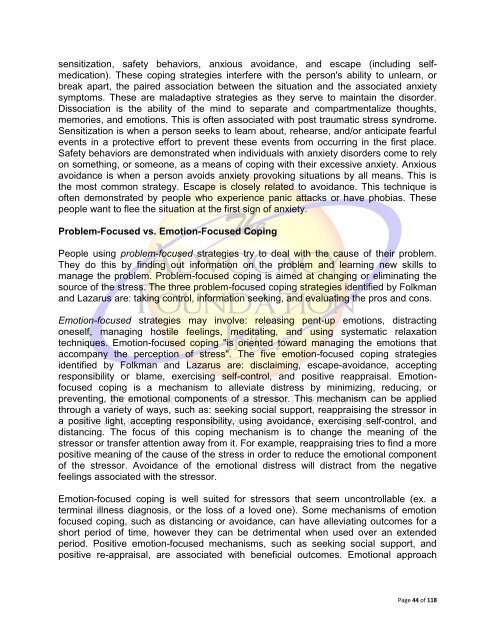The Gift of Adversity
The Gift of Adversity
The Gift of Adversity
Create successful ePaper yourself
Turn your PDF publications into a flip-book with our unique Google optimized e-Paper software.
sensitization, safety behaviors, anxious avoidance, and escape (including selfmedication).<br />
<strong>The</strong>se coping strategies interfere with the person's ability to unlearn, or<br />
break apart, the paired association between the situation and the associated anxiety<br />
symptoms. <strong>The</strong>se are maladaptive strategies as they serve to maintain the disorder.<br />
Dissociation is the ability <strong>of</strong> the mind to separate and compartmentalize thoughts,<br />
memories, and emotions. This is <strong>of</strong>ten associated with post traumatic stress syndrome.<br />
Sensitization is when a person seeks to learn about, rehearse, and/or anticipate fearful<br />
events in a protective effort to prevent these events from occurring in the first place.<br />
Safety behaviors are demonstrated when individuals with anxiety disorders come to rely<br />
on something, or someone, as a means <strong>of</strong> coping with their excessive anxiety. Anxious<br />
avoidance is when a person avoids anxiety provoking situations by all means. This is<br />
the most common strategy. Escape is closely related to avoidance. This technique is<br />
<strong>of</strong>ten demonstrated by people who experience panic attacks or have phobias. <strong>The</strong>se<br />
people want to flee the situation at the first sign <strong>of</strong> anxiety.<br />
Problem-Focused vs. Emotion-Focused Coping<br />
People using problem-focused strategies try to deal with the cause <strong>of</strong> their problem.<br />
<strong>The</strong>y do this by finding out information on the problem and learning new skills to<br />
manage the problem. Problem-focused coping is aimed at changing or eliminating the<br />
source <strong>of</strong> the stress. <strong>The</strong> three problem-focused coping strategies identified by Folkman<br />
and Lazarus are: taking control, information seeking, and evaluating the pros and cons.<br />
Emotion-focused strategies may involve: releasing pent-up emotions, distracting<br />
oneself, managing hostile feelings, meditating, and using systematic relaxation<br />
techniques. Emotion-focused coping "is oriented toward managing the emotions that<br />
accompany the perception <strong>of</strong> stress". <strong>The</strong> five emotion-focused coping strategies<br />
identified by Folkman and Lazarus are: disclaiming, escape-avoidance, accepting<br />
responsibility or blame, exercising self-control, and positive reappraisal. Emotionfocused<br />
coping is a mechanism to alleviate distress by minimizing, reducing, or<br />
preventing, the emotional components <strong>of</strong> a stressor. This mechanism can be applied<br />
through a variety <strong>of</strong> ways, such as: seeking social support, reappraising the stressor in<br />
a positive light, accepting responsibility, using avoidance, exercising self-control, and<br />
distancing. <strong>The</strong> focus <strong>of</strong> this coping mechanism is to change the meaning <strong>of</strong> the<br />
stressor or transfer attention away from it. For example, reappraising tries to find a more<br />
positive meaning <strong>of</strong> the cause <strong>of</strong> the stress in order to reduce the emotional component<br />
<strong>of</strong> the stressor. Avoidance <strong>of</strong> the emotional distress will distract from the negative<br />
feelings associated with the stressor.<br />
Emotion-focused coping is well suited for stressors that seem uncontrollable (ex. a<br />
terminal illness diagnosis, or the loss <strong>of</strong> a loved one). Some mechanisms <strong>of</strong> emotion<br />
focused coping, such as distancing or avoidance, can have alleviating outcomes for a<br />
short period <strong>of</strong> time, however they can be detrimental when used over an extended<br />
period. Positive emotion-focused mechanisms, such as seeking social support, and<br />
positive re-appraisal, are associated with beneficial outcomes. Emotional approach<br />
Page 44 <strong>of</strong> 118

















